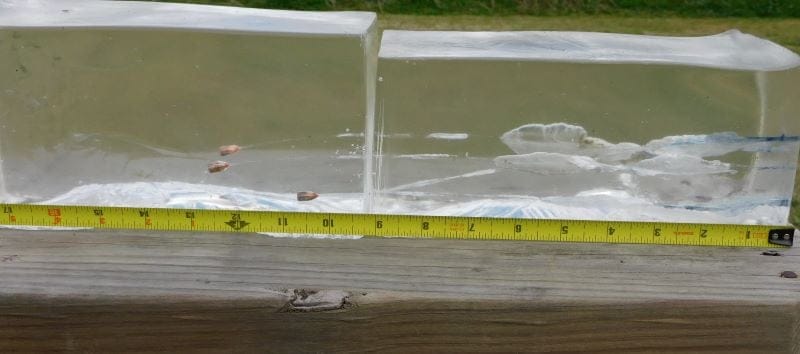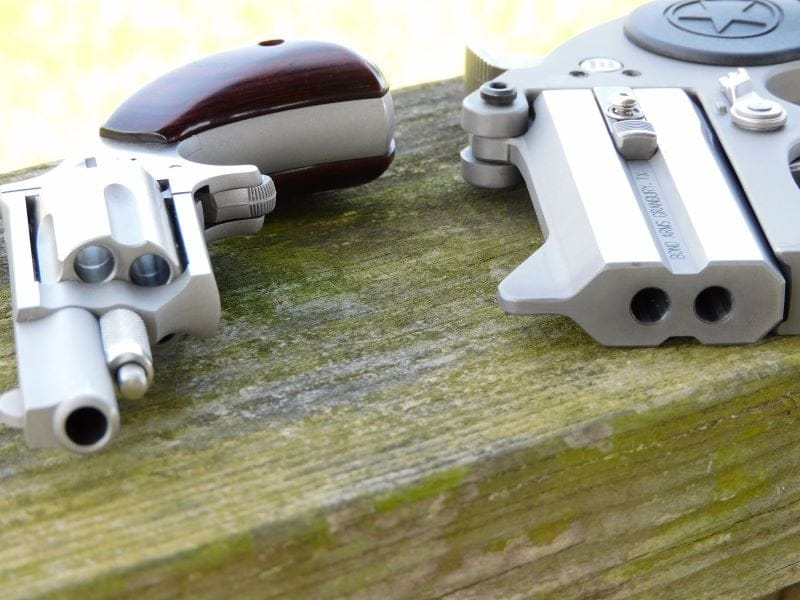Although they are elusive creatures in big box stores, it is hard to find a local mom-and-pop gun shop that does not have a few North American Arms mini-revolvers in stock. These five-shot palm-sized stainless steel wheel guns stand out as among the smallest handguns you can buy. It certainly stood out to me when I first saw one. Revolvers require hand fitting to function properly and North American Arms guns have a fit and finish beyond the typical revolver. They also accomplished this with tiny parts to make a tiny revolver. You might think of the NAA Mini revolver as the Swiss watch of the gun world.
Beyond their craftsmanship, the appeal of the NAA Mini is obvious. Many people want to carry a small gun. Some want to carry without a change of wardrobe. Some want a gun that is impossible to spot. Others view a gun as a gun and they all work the same. Right?

I have owned and fired several NAA Minis over the years. It was an NAA Mini Revolver that once saved my hide on a summer day in Daytona Beach. But outside very niche circumstances, the NAA Mini is a problematic handgun. As I read reviews and sift through forums, I see many owners and potential owners become hypnotized by the gun’s craftsmanship and handiness. Performance goes by the wayside when you have to shoot seriously.
Function and Features
To understand the deficiencies of the NAA Mini Revolver, we have to understand the subject in general. Back in 1978, Dick Casull of Freedom Arms created a five-shot stainless steel 22-caliber micro-revolver. It was a difference in kind for the man who created the 454 Casull and big-bore big-framed handguns in other interesting magnum calibers.
In 1990, North American Arms out of Provo, Utah acquired the rights and ran with the design. The NAA Mini Revolver is chiefly chambered in 22 Short, 22 Long Rifle, and 22 Magnum and comes in a variety of barrel lengths, grips, and sight configurations. Over the last 10 years, North American Arms has also created spin-off designs for faster reloading like the NAA Sidewinder with a swing-out cylinder and the Ranger II with a break-top action.

Handy and Waterproof
All versions of the NAA Mini Revolver are single-action handguns, requiring the hammer to be cocked for every shot. Pulling the trigger, by itself, does not fire the handgun. Most versions of the NAA, aside from the Sidewinder and Ranger, require the cylinder to be removed from the revolver’s frame for loading and unloading. Most versions also come with a barrel length between 1 1/8 and 2 inches, depending on what model you get. On the other hand, a typical 22 Magnum Mini comes in at seven ounces fully loaded and can be stashed just about anywhere. It can be carried all day and its stainless-steel construction makes it largely impervious to moisture.

The Bad News?
Low Power and Low Capacity
The main criticism of the North American Arms Mini Revolver is its low power and low capacity. It is a criticism I don’t fully embrace. Certainly, we would all want to carry a full-sized handgun with a few dozen rounds ready to go. But you can’t get one that goes into your pocket or works with swim trunks. But there is no getting around the fact that the NAA Mini is light on firepower.
Most Minis use a 1 1/8 or 1 5/8 inch barrel. Some models like the Pug and Black Widow come with a 1 or 2-inch barrel respectively. The most formidable round available for the Mini, the 22 Winchester Magnum cartridge, is a rifle cartridge. Out of a short barrel, the round loses close to half the advertised velocity on the box. One of my favorite NAA Minis is the Sidewinder with a 2.5-inch barrel. Even with this extra barrel length, CCI Maxi Mag 40 grain loads run out of this pistol at 991 feet per second. The advertised rifle velocity is 1875 feet per second. The picture does not get much better when going to even shorter barrels.
Firing a NAA Mini 22 Magnum is akin to firing standard velocity 22 LR loads out of a rifle. Toting a Mini in 22 LR or 22 Short complicates the calculus further. The 22 LR guns are slightly smaller in size than the Magnum frame guns but the ballistics are reduced to 22 Short rifle velocities.

The NAA 22 Short is the smallest of them all, weighing in at 4.2 ounces unloaded. It is so small that you will get powder on your fingers with every shot. But those little rounds struggle to get past the 600 feet per second mark. Still, CCI 22 Shorts will still penetrate upwards of 7 inches into 10% ordinance gelatin. The 22 Magnum round, although hobbled by that short barrel, can easily punch a bullet past 12-14 inches in the same medium.
Ballistically, none of these rounds are great but are not to be trifled with either. Unfortunately, you are limited to five rounds. The base Mini requires the cylinder to be removed and the empty cases punched out with the cylinder pin. Models like the Sidewinder and the Ranger II speed up the reload a little, but performing a reload in a fight will be dubious at best.
We must keep things in perspective. All of these rounds can work in a defensive role. A five-shot 22 is objectively light for a primary self-defense loadout, but it can be wholly adequate in the backup role. Likewise, it might be all you can carry in some situations. On the Mini, a lot of attention is given to its ease of carry, ballistics, and capacity, but it allows the real problems with the Mini to fly under the radar. The small size of the Mini comes at a large cost: small controls, a tendency to keyhole bullets, and an overall flawed and fragile design.

Small Controls
Anyone who has seen a NAA Mini can tell it is a small gun. No surprise there. Most come with small rosewood grips that can accommodate a one-finger hold. The hammer reach is short, perhaps too short. But it is easy enough to thumb back. But cocking the hammer while maintaining a hold on the pistol is tricky to do. And while firing the pistol, you have to make sure all your fingers are away from the cylinder gap. This is all but impossible to accomplish with the NAA 22 Short. The Short will kick your fingers. I can’t imagine what a Magnum Mini might do to your hand if you are not careful.
To compound the cramped shooting experience is the general lack of sights. There is an immovable front post and a notch in the rear that is easy to mistake for a rear sight. It is not. The Mini only has a true front sight that is indexed on the target. These issues can be mitigated to a degree by opting for the Pug or Black Widow models that have moveable sights and more substantial grips, but shooting some of the same challenges will remain.
With some practice, what little sights there are on the standard Mini can be understood. But it is still not ideal. While some apologists will opine that the NAA Mini is a belly gun to be used at point-blank range, you do not get to decide the engagement distance. The lack of sights combined with the stubby controls will make it hard to shoot quickly and accurately for the average shooter.
Barrel Length and Quality
We have already established that the NAA Mini revolver is ballistically effective despite its shorter barrel lengths. Unfortunately, there is another consideration to firing 22 rimfire rounds out of barrels under two inches. That is the phenomenon of keyholing.
If the barrel does not have sufficient length or has too slow of a twist to its rifling, some bullets will not completely stabilize when they leave the muzzle. At best, it will make the size of a group open up. At worst, bullets will hit the target sideways, leaving a keyhole. While a keyhole looks nasty on paper, they do not land with any accuracy and do not penetrate much into a target. It is easier to stop a slow ¾-inch keyholed projectile than a faster, pointed .22-inch one.
While I have seen keyholing with rimfire ammunition occasionally on other pistols, it is a feature rather than a bug on some NAAs, particularly the shortest-barreled models. The solution can usually be found by switching to a lighter-grained bullet.
But sometimes, the problem does not go away. If that is the case, check out the crown at the muzzle. While premium models like the Pug or Black Widow do come with a crown at the muzzle, most NAAs do not have one. The crown prevents damage to the muzzle of the pistol and also allows for uniform surface for the bullet and escaping gas just as it leaves the muzzle. An uneven or unfinished crown can throw bullets well before they hit the target.
I have owned two NAAs that tossed bullets no matter what ammunition I used. I resorted to using a brass screw and polishing compound to work through the finish and impart a light crown on the muzzle. Problem solved!

Fragility
Without some elbow grease, an unfinished crown would ordinarily warrant a trip back to the factory. But it also takes an extraordinary amount to avoid sending it back if any of the internal parts break. The mainspring, hand, hand spring, and cylinder stop mechanism are tiny to match a tiny gun. These parts will not hold up to prolonged shooting like those in a large revolver would.
While most gun parts should be changed out at regular intervals to ensure reliability, working on the tiny NAA Mini and its tiny parts requires a jeweler’s skill and tools not commonly found on the bench of the average shooter. Unless you are willing to dedicate the time to the insides of the NAA Mini, it requires a factory trip to get up and running after a parts breakage.
But what is the life expectancy of a NAA with stock parts? Given that most folks will not fire them much, it might be a long time. However, if you want to be proficient with this life-saving tool, you will have to put some wear and tear on it. Some NAA Minis seem to go forever. My Sidewinder model has close to 2,000 rounds downrange and my Short model has close to 800. These revolvers had no issues at all. However, I have owned two Magnum models that went down. One with a broken handspring at the 600-round mark and one with a broken mainspring after thirty rounds downrange.
The Bottom Line
The NAA Mini revolver is an impressive feat of firearms engineering that has saved countless lives. Although it is hard to find confidence in a small gun, the NAA’s portability and surprisingly good ballistics make it perfect for those occasions where a larger gun is impossible. But when it comes to shooting the Mini proficiently, the little gun has issues. There is not much gun there to manipulate. Sometimes there is not much gun to stabilize the bullets that come out of it. But worst of all, there is often not enough gun to go bang when you need it to. Nothing I say should be a dictate to sell your Mini or to buy one. I simply want more NAA owners and potential owners to understand their benefits and vulnerabilities with eyes wide open.

